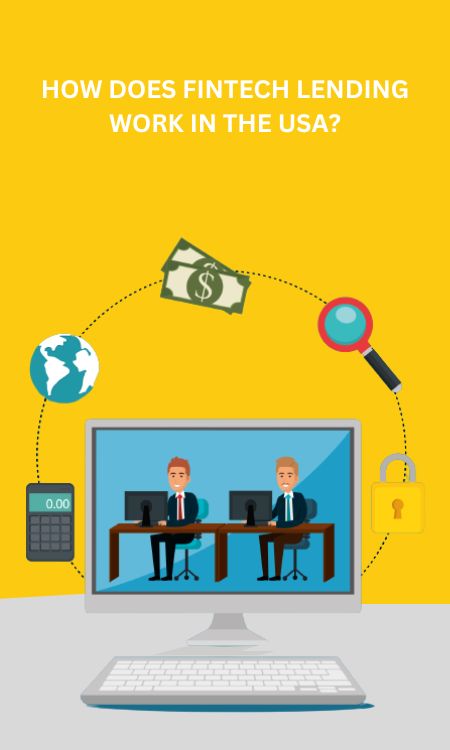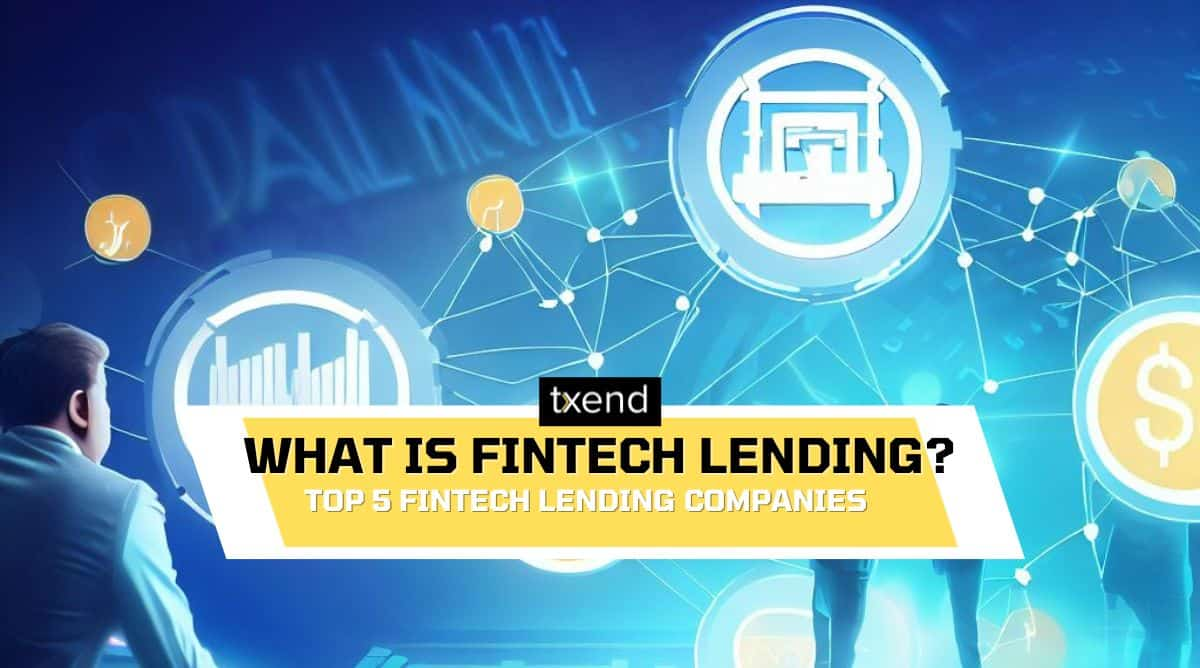In the ever-evolving landscape of finance, a revolutionary force has emerged, reshaping the way we borrow, lend, and manage our finances—Fintech Lending.
This dynamic blend of finance and technology has democratised access to loans and streamlined and personalised the borrowing experience like never before.
But what exactly is financial technology lending, and how does it impact our financial world?

What Is Fintech Lending?
In this article, we delve extensively into the world of financial technology lending.
We examine its advantages, offer practical instances, and illuminate the potential drawbacks linked to this revolutionary financial trend.
Whether you’re a borrower, investor, or simply curious about the future of lending, join us on this enlightening journey through the world of financial technology lending.
FinTech Lending in the USA
In the USA, financial technology lending denotes the inventive application of technology to offer financial services pertaining to loans and borrowing.
It involves online platforms and apps that connect borrowers with lenders, offering a wide range of loan products, including personal loans, mortgages, student loans, and small business loans.
It leverages data analytics, automation, and streamlined processes to make borrowing faster, more accessible, and often more cost-effective than traditional financial institutions.
This digital approach aims to enhance the borrower’s experience, increase transparency, and provide quicker access to credit while presenting unique benefits, potential risks, and regulatory considerations in the financial landscape.
How does fintech lending work in the USA?
Financial technology lending in the USA operates through digital platforms that connect borrowers and lenders in an efficient and user-friendly manner.

Here’s how it works:
Online Application:
Borrowers visit a financial technology lending platform’s website or mobile app and complete an online application, providing personal and financial information.
Credit Evaluation:
Fintech lenders employ advanced algorithms and data analytics to assess the borrower’s creditworthiness.
This process may include analyzing credit scores, income, employment history, and other relevant data points.
Loan Offers:
Based on the borrower’s profile, the fintech platform generates loan offers with specific terms, including interest rates and repayment schedules.
Borrowers can review and choose the loan that best suits their needs.
Digital Verification:
Fintech lenders often use digital tools to verify the borrower’s identity and financial information.
This includes verifying bank accounts, income sources, and other documentation.
Approval and Funding:
Once approved, the borrower receives the loan amount directly into their bank account.
The entire process is typically faster than traditional lending institutions, often providing same-day or next-day funding.
Repayment:
Borrowers repay the loan according to the agreed-upon schedule.
Many fintech lenders offer flexible repayment options, including automatic deductions from bank accounts.
Practical Example:
Consider a borrower in the USA who needs a personal loan for a home improvement project.
They visit a financial technology lending platform, complete an online application, and are quickly presented with loan offers from different lenders.
They choose an offer with a competitive interest rate and favorable terms.
After digital verification, they receive the loan amount in their bank account within 24 hours.
They make regular monthly payments until the loan is fully repaid.
Types of Fintech Lenders in the USA
This streamlined and digitised process exemplifies how financial technology lending in the USA simplifies access to credit, reduces administrative overhead, and enhances the borrower experience.
In the USA, financial technology lending encompasses various lenders catering to diverse borrowing needs.

Here are the primary types of fintech lenders:
Peer-To-Peer (P2P) Lending:
P2P lending platforms directly connect individual investors or lenders with borrowers.
These platforms facilitate loans for personal, business, or other purposes.
Example:
A borrower seeking a personal loan applies on a P2P platform. Multiple investors contribute funds, collectively funding the loan.
The borrower repays the loan with interest, distributing returns to the investors.
Investor Loans:
Investor-focused fintech lenders provide loans for investment purposes, such as real estate investment.
These loans enable investors to expand their portfolios.
Example:
A real estate investor looks to purchase additional properties. They apply for an investor loan from a fintech lender specialising in real estate investment.
Upon approval, they use the funds to acquire a new property to generate rental income or capital gains.
Mortgages:
Fintech mortgage lenders streamline the home loan application and approval process.
They offer competitive rates and digitised services, making homeownership more accessible.
Example:
A prospective homebuyer applies for a mortgage through a fintech lender.
The lender employs automated underwriting and data analysis to assess creditworthiness quickly.
If approved, the borrower secures a mortgage to purchase their home.
Business Loans:
Fintech lenders specializing in business loans cater to small and medium-sized enterprises (SMEs).
They offer financing solutions to support business growth, including working capital loans and equipment financing.
Example:
An entrepreneur needs funding to expand their e-commerce business.
They apply for a business loan from a fintech lender, which reviews their business’s financial health and creditworthiness.
If approved, the loan helps the entrepreneur scale their operations.
These types of fintech lenders in the USA illustrate the versatility and accessibility of fintech lending, serving a wide range of borrowers, investors, and businesses.
These lenders’ digital and data-driven nature enhances efficiency and often results in quicker loan approvals and disbursements compared to traditional financial institutions.
FinTech Lending versus Traditional Lenders
Financial technology lending and traditional lenders in the USA differ in several key aspects:
Digital Approach vs. Brick-and-Mortar Presence:
Financial technology lending:
Fintech lenders operate primarily online, offering borrowers the convenience of applying for loans, managing accounts, and making payments through digital platforms and mobile apps.
Conventional Lenders:
Conventional lending institutions such as banks and credit unions operate physical branches and offer online banking services.
They often require borrowers to visit branches for loan applications and other transactions.
Speed and Efficiency:
Financial technology lending:
Fintech lenders leverage automation and data analytics for rapid loan approval and disbursement, enabling borrowers to access funds quickly.
Traditional Lenders:
Traditional lenders may involve a more lengthy and paperwork-intensive approval process, leading to longer wait times for loan approvals and funding.
Credit Assessment Methods:
Fintech Lending:
Fintech lenders often use alternative data sources and advanced algorithms to assess creditworthiness, making it possible for individuals with limited credit history to secure loans.
Traditional Lenders:
Traditional lenders typically rely heavily on traditional credit scores, which may limit borrowing opportunities for those with less-established credit histories.
Personalization and Targeting:
Financial technology lending:
Fintech lenders can offer more personalised loan products and terms based on individual borrower profiles and needs, enhancing the borrower experience.
Traditional Lenders:
Traditional lenders may need more flexibility in tailoring loan offerings, leading to more standardised loan products.
Regulatory Environment:
Financial technology lending:
Fintech lenders often face evolving regulatory frameworks that may vary by state.
Compliance with these regulations is crucial to their operations.
Traditional Lenders:
Traditional lenders have a long history of adhering to established regulatory requirements, which can be both an advantage and a challenge.
Accessibility and Inclusivity:
Financial technology lending:
Fintech lending platforms seek to enhance financial inclusivity by granting loans to underprivileged segments, including individuals lacking access to conventional banking facilities.
Traditional Lenders:
Traditional lenders may have stricter eligibility criteria, potentially excluding certain individuals or businesses.
Risk Assessment and Management:
Financial technology lending:
Fintech lenders often employ real-time monitoring and advanced risk management techniques to mitigate potential defaults and fraud.
Traditional Lenders:
Traditional lenders may rely on historical data and manual processes, which can be less agile in identifying and responding to risks.
While both Financial technology lending and traditional lending serve the borrowing needs of individuals and businesses, these differences highlight the evolving landscape of lending in the USA.
Fintech lending’s emphasis on technology, speed, and personalisation has disrupted traditional lending models, offering borrowers greater choice and accessibility in the financial services arena.
FinTech Lender Examples in the USA
Several notable fintech lenders operate in the USA, each offering unique lending solutions. Here are some examples:
LendingClub:
LendingClub is a prominent peer-to-peer lending platform that connects borrowers with individual investors.
It offers personal loans for various purposes, including debt consolidation and home improvement.
SoFi (Social Finance):
SoFi provides a wide range of financial products, including student loan refinancing, personal loans, mortgages, and investment services. It’s known for its member benefits and competitive rates.
Rocket Mortgage by Quicken Loans:
Rocket Mortgage offers a digital mortgage application experience, allowing homebuyers to apply for mortgages, refinance loans, and manage their home financing entirely online.
Upgrade:
Upgrade offers personal loans with features like credit monitoring and access to higher credit lines.
It aims to provide responsible and affordable lending options to consumers.
Kabbage (Now part of American Express):
Kabbage specializes in small business lending, offering lines of credit and working capital solutions for entrepreneurs and small businesses.
Avant:
Avant focuses on personal loans, particularly for individuals with less-than-perfect credit.
It uses advanced analytics to assess borrowers’ creditworthiness.
OnDeck (Now part of Enova International):
OnDeck provides small business loans and lines of credit, leveraging technology to simplify the application and approval process for business owners.
GreenSky:
GreenSky offers point-of-sale financing solutions, allowing consumers to finance home improvement projects and elective medical procedures at the point of sale.
Affirm:
Affirm specializes in point-of-sale financing, allowing consumers to make purchases and pay for them over time with transparent, fixed installment plans.
Funding Circle:
Funding Circle is a peer-to-peer lending platform focusing on small business loans, connecting business owners with investors looking to fund business expansion.
These examples represent a diverse range of fintech lenders in the USA, catering to various borrowing needs, from personal loans and mortgages to small business financing.
Each lender leverages technology to simplify the lending process, enhance transparency, and give borrowers faster access to funds.
Benefits For Consumers of FinTech Lending in the USA
Accessibility:
Fintech lenders often have more inclusive eligibility criteria, making it easier for a broader range of individuals to access credit, including those with limited credit histories.
Speed:
The digital nature of Financial technology lending results in quicker loan approval and funding, allowing consumers to address financial needs promptly.
Convenience:
Borrowers can apply for loans, manage accounts, and make payments through user-friendly online platforms and mobile apps, enhancing the overall borrowing experience.
Competitive Rates:
Fintech lenders frequently offer competitive interest rates and fees, potentially saving consumers money compared to traditional lenders.
Personalization:
Fintech lenders use data analytics to personalize loan offerings, tailoring terms to individual borrower profiles and needs.
Transparency:
Financial technology lending platforms often provide clear and concise terms and conditions, ensuring borrowers understand the terms of their loans.
Financial Education:
Certain fintech lenders provide educational materials to assist individuals in enhancing their financial knowledge and effectively managing their monetary affairs.
Diverse Loan Options:
Financial technology lending encompasses various loan types, including personal loans, mortgages, and small business loans, giving consumers a wider array of financing choices.
Enhanced Risk Management:
Fintech lenders use advanced risk assessment tools to better evaluate creditworthiness and mitigate risks, potentially reducing default rates.
Financial Inclusion:
Financial technology lending aims to bridge gaps in financial access, particularly for underserved populations, promoting greater financial inclusion.
These benefits make Financial technology lending an attractive option for consumers in the USA, offering them convenient, accessible, and often more affordable financing solutions tailored to their unique financial situations and goals.
Benefits for Lenders of FinTech lending in the USA
Enhanced Financial Transparency:
Financial technology lending platforms leverage data analytics and alternative credit scoring methods, providing lenders with a more comprehensive view of borrowers’ financial profiles.
This enhanced transparency helps lenders make more informed lending decisions and assess creditworthiness accurately.
Streamlined Loan Approval Process:
Financial technology lending streamlines and automates the loan origination and approval process.
By utilizing advanced algorithms and digital tools, lenders can expedite the evaluation of loan applications, reducing manual paperwork and administrative burdens.
This efficiency not only saves time but also reduces operational costs.
Risk Mitigation through Data Analytics:
Fintech lenders employ sophisticated data analytics to assess and manage risk effectively.
By continuously monitoring borrower behavior and market trends, lenders can identify potential risks early and adjust lending strategies accordingly, reducing the likelihood of defaults.
Diversification of Loan Portfolios:
Financial technology lending platforms allow lenders to diversify their loan portfolios by offering a wide range of lending products, including personal loans, mortgages, and small business loans.
This diversification spreads risk and can lead to more stable returns for lenders.
Improved Customer Relationship Management:
Financial technology lending fosters better borrower-lender relationships through digital communication channels.
Lenders can interact with borrowers in real time, addressing inquiries and concerns promptly, enhancing customer satisfaction, and building brand loyalty.
Cost Efficiency:
Financial technology lending reduces operational costs associated with traditional lending methods.
With automation, lenders can minimize the need for manual processes, paperwork, and physical infrastructure, leading to cost savings.
Access to New Markets:
Financial technology lending enables lenders to reach a broader and often younger demographic of borrowers who prefer digital financial services. This access to new markets and customer segments can drive growth and expansion.
Data-Driven Decision Making:
Financial technology lending relies on data-driven decision-making processes, enabling lenders to accurately assess loan risks and opportunities.
This data-centric approach empowers lenders to adjust strategies and pricing models in response to changing market dynamics.
Overall, Financial technology lending empowers lenders in the USA with advanced technology and data-driven insights, allowing them to make informed lending decisions, enhance operational efficiency, and manage risk effectively while offering borrowers a more comprehensive range of financial products.
Financial technology lending Risks
Credit Risk:
Fintech lenders may face credit risk, as loans are extended to a diverse range of borrowers, including those with limited credit histories.
This can result in higher default rates, impacting loan portfolio performance.
Regulatory and Compliance Risk:
The evolving regulatory landscape in the fintech lending sector can pose compliance challenges.
Non-compliance with state and federal regulations can lead to legal and financial consequences for lenders.
Cybersecurity Threats:
Fintech lenders are susceptible to cybersecurity threats, including data breaches and fraud.
Protecting sensitive borrower information is crucial to maintaining trust and compliance.
Market and Economic Volatility:
Fluctuations in the economy or shifts in market conditions can impact borrowers’ capacity to meet their loan repayment obligations. Fin
tech lenders must be prepared to manage loan defaults during economic fluctuations.
Operational Risk:
Technical glitches, system failures, or disruptions in digital lending operations can disrupt the loan origination and servicing process, impacting customer experience and lender reputation.
Lack of Physical Collateral:
Fintech loans, particularly unsecured personal loans, lack physical collateral. In the event of default, lenders may have limited recourse to recover losses.
Competition and Pricing Pressure:
The Financial technology lending industry is highly competitive, with numerous players vying for market share.
This competition can lead to pricing pressure, potentially affecting lenders’ profitability.
Data Privacy and Ethics:
Managing borrower data ethically and in compliance with privacy regulations is critical.
Mishandling of data can result in reputational damage and legal consequences.
Scalability Challenges:
Rapid growth can present scalability challenges for fintech lenders.
Ensuring that technology infrastructure can handle increased loan origination volumes is crucial for sustainable growth.
Loan Stacking:
Borrowers may engage in loan stacking, taking out multiple loans from different fintech lenders simultaneously.
This can increase the risk of default and make it challenging for lenders to assess a borrower’s indebtedness.
To mitigate these risks, fintech lenders in the USA must implement robust risk assessment models, maintain compliance with regulatory requirements, invest in cybersecurity measures, and continuously monitor and adapt to market conditions.
Fostering responsible lending practices and transparency is essential for building trust with borrowers and investors.
Trends in Fintech Lending
Digital-First Lending Platforms:
Fintech lenders increasingly adopt digital-first approaches, allowing borrowers to complete the loan application and approval process online or through mobile apps.
This trend enhances convenience and expedites loan origination.
Personalized Loan Products:
Fintech lenders leverage data analytics and artificial intelligence to offer personalized loan products.
Borrowers receive loan offers tailored to their financial profiles, improving their borrowing experience.
Partnerships with Traditional Financial Institutions:
Some fintech lenders partner with traditional banks and credit unions to expand their reach and offer fintech-powered lending solutions to a broader customer base.
Use of Alternative Data:
Fintech lenders utilize alternative data sources, such as utility bill payment history and rent payments, to assess creditworthiness.
This allows them to serve individuals with limited traditional credit histories.
Increased Focus on Regulatory Compliance:
Fintech lenders prioritize regulatory compliance by adapting to changing financial regulations and ensuring adherence to state and federal lending laws.
Compliance management is a key area of investment.
Small Business Lending:
Financial technology lending extends to small business owners, providing quick access to working capital through digital platforms.
This trend supports entrepreneurship and economic growth.
Sustainable and Responsible Lending:
Many fintech lenders are emphasizing sustainable and responsible lending practices.
They assess loans’ environmental and social impacts, promoting ethical lending decisions.
Integration of AI and Machine Learning:
Artificial intelligence (AI) and machine learning (ML) algorithms are employed to enhance the evaluation of credit risk, identify fraudulent activities, and enhance interactions with borrowers.
These technologies enhance lending efficiency and accuracy.
Expansion into New Loan Types:
Fintech lenders diversify their loan offerings to include auto, student, and mortgages, expanding their presence in various lending segments.
Secondary Markets and Securitization:
Some fintech lenders are securitizing loans and participating in secondary markets, attracting institutional investors and further fueling the growth of Financial technology lending.
Focus on Financial Inclusion:
Fintech lenders are committed to increasing financial inclusion by serving underbanked and underserved populations.
They aim to bridge the financial access gap.
These trends reflect the evolving landscape of Financial technology lending in the USA, characterized by innovation, digitalization, and a commitment to providing accessible and responsible financial solutions to consumers and businesses.
Top 5 Fintech Lending Companies
LendingClub:
LendingClub is one of the USA’s largest and most well-known peer-to-peer lending platforms.
It connects borrowers with investors and offers personal, small business, and auto refinancing loans.
SoFi (Social Finance):
SoFi offers various financial products, including student loan refinancing, personal loans, mortgages, and investment services.
It has gained popularity for its member benefits and community-focused approach.
OnDeck (Now part of Enova International):
OnDeck specializes in offering loans and lines of credit tailored for small businesses and entrepreneurs.
It focuses on quick and convenient lending solutions for businesses.
Avant:
Avant provides personal loans to individuals with varying credit scores.
It utilizes advanced data analytics to provide customized loan offers and has served millions of customers.
Kabbage (Now part of American Express):
Kabbage is known for its innovative approach to small business lending.
It offers lines of credit to small businesses and uses automated technology for rapid approvals.
These Financial technology lending companies have made significant strides in revolutionizing the lending industry by leveraging technology and data-driven approaches to provide borrowers with faster access to funds, competitive rates, and a streamlined borrowing experience.
How Txend can Help You Leverage Financial technology lending Solutions in the USA
Txend can assist individuals and businesses in the USA to harness Financial technology lending solutions by offering:
Personalized Loan Matching:
Txend utilizes advanced algorithms to match borrowers with suitable lenders, ensuring loan offers align with specific financial needs and profiles.
Access to Diverse Lending Products:
Txend provides access to a wide range of fintech lending products, including personal loans, mortgages, and business loans, allowing borrowers to explore various options.
Streamlined Application Process:
Txend simplifies the loan application process, enabling users to apply for loans online or via mobile apps, reducing paperwork and expediting approvals.
Transparent Terms and Rates:
Txend places a strong emphasis on transparency, ensuring that borrowers possess a clear comprehension of their loan conditions, interest rates, and associated fees.
Data Security:
Txend prioritizes data security, implementing robust measures to protect sensitive borrower information and maintain user trust.
Financial Education:
Txend offers resources and educational materials to help borrowers make informed financial decisions and improve their financial literacy.
Responsive Customer Support:
Txend provides responsive customer support to address inquiries and concerns, enhancing the overall borrower experience.
By leveraging Txend’s platform, borrowers can access a network of trusted fintech lenders, discover tailored loan solutions, and benefit from a user-friendly digital lending experience.
This enables individuals and businesses to navigate the evolving landscape of Financial technology lending in the USA more effectively and make well-informed borrowing decisions.
Frequently Asked Questions:
Credit lending involves providing funds to borrowers with an agreement to repay, often with interest, over a specified period.
Fintech enhances digital lending by automating processes, assessing credit risk using data analytics, and enabling convenient online loan transactions.
Conclusion
In conclusion, fintech lending in the USA offers a transformative approach to borrowing, providing benefits such as accessibility, speed, and personalized solutions.
However, it’s essential to be aware of the risks associated with this evolving financial landscape.
By understanding the benefits, examples, and risks of Financial technology lending, individuals and businesses can make informed financial decisions and leverage the opportunities presented by this dynamic industry.



